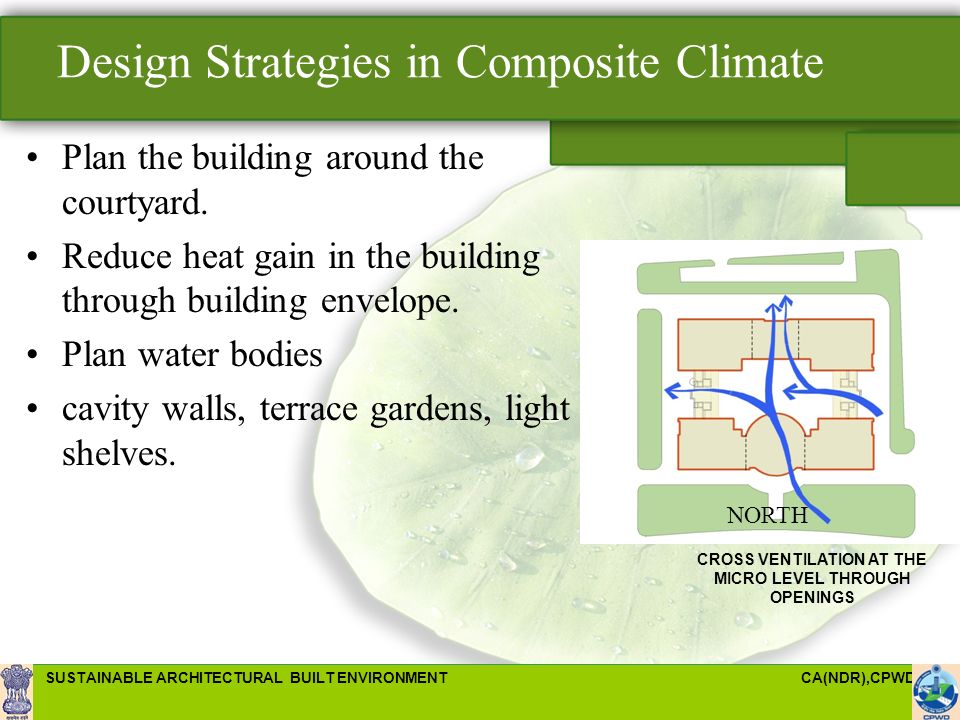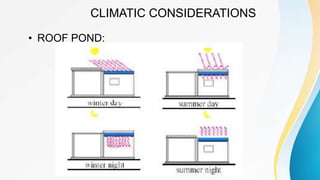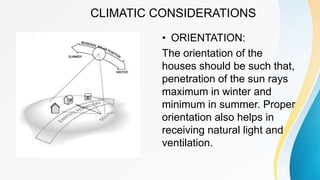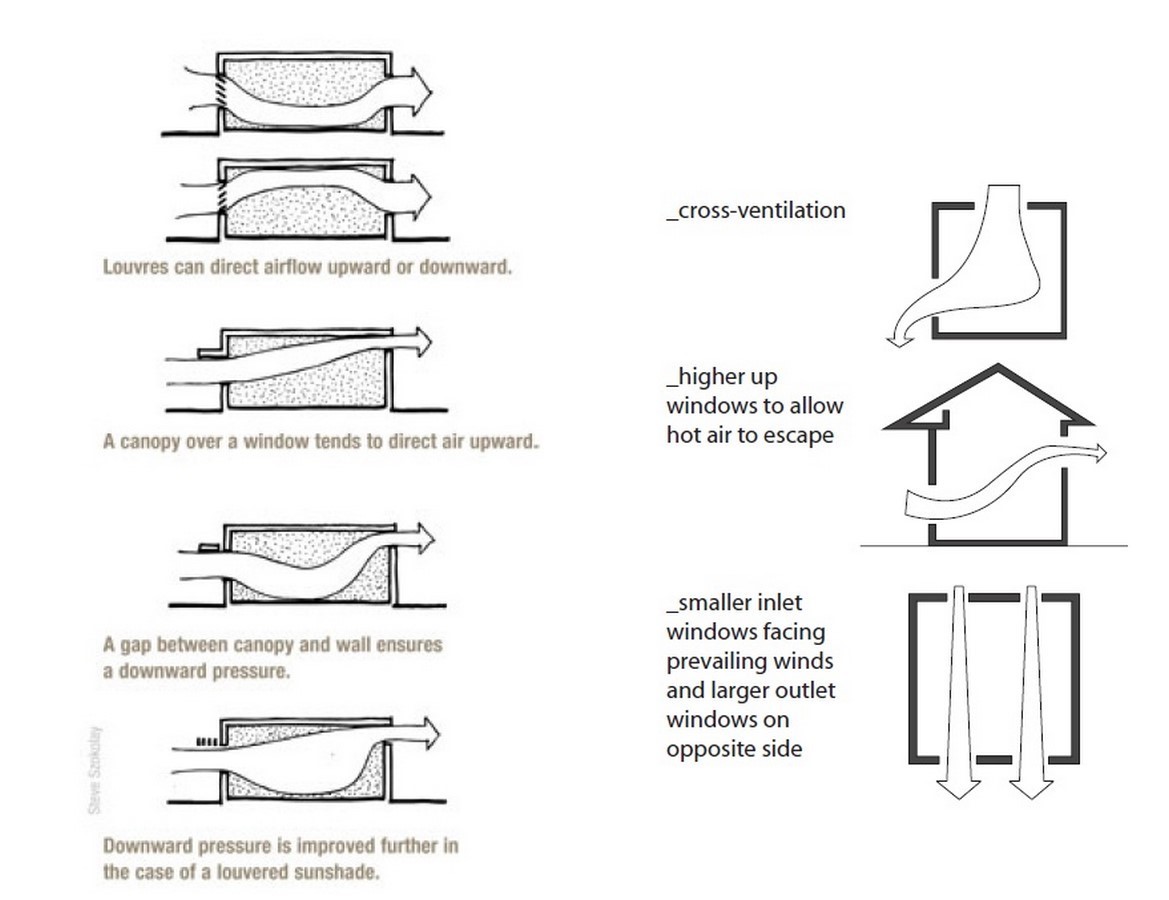Mahdavi and Kumar 1996. The climate resilience design considerations for each of those linked sections as well as additional climate resilience resources by section are included in this document for easy reference.

Sustainable Architectural Built Environment Ppt Video Online Download
Solar radiation outside air wet surfaces vegetation etc means in composite climate.

. The place experiences three definite seasons. Often referred to as climatology it is to study the various climate-based influencing factors on our living conditions particularly under the heads of seasonality sunlight rain wind and humidity of the target construction site for maximal dialogue between the structure and its surroundings in particular the climate. CLIMATIC CONSIDERATIONS IN ARCHITECTURAL DESIGN OF BUILDINGS IN TROPICS.
Compact form with low SV ratio is recommended. CLIMATE RESPONSIVE DESIGN STRATEGIES IN COMPOSITE CLIMATE In passive solar energy mechanical means are not employed to utilize solar energy. Considerations for buildings to become comfortable include realisation of an open barrier between the indoor and outdoor climate make use of solar and natural ventilation strategies and allowance for human intervention in climate control to satisfy subjective needs Fountain et al 1996.
This paper focuses on various bioclimatic design strategies Orientation of building plays a vital role in achieving energy for building design in a composite climate like Delhi. Jalis on the outer facade of the building helps in cooling shading and ventialtion. Design Considerations for Climate Change.
Now the physiological objectivefor composite climate becomes very difficult. Use minimal heating or cooling. CLIMATIC CONSIDERATIONS PROJECTIONS.
This communication presents design considerations and thermal performance of a hostel building using passive techniques for a composite climatic condition of Delhi India. The scope of work for projects may include a copy of the completed RRVA for reference or the Design Consultant may request a copy. The design should also consider projected changes to the climate.
In that case a heating coil can be needed to cool the air beyond the desired temperature and then heat it. CLIMATIC CONSIDERATIONS JALIS. An architects aim would be to.
And the sky conditions are againvariable which because it experiences all the 3 seasons. The flat roof is a good reflector and re-radiates heat efficiently especially if it consists of a solid white painted material. Passive strategies provide thermal and visual comfort by using natural energy sources sinks.
A CASE STUDY OF HOT DRY AND WARM HUMID CLIMATES IN NIGERIA. Passive solar systems basic rules-1. The buildings south face should receive sunlight between the hours of 900 AM.
There are different ways to design an air-conditioning. Design for climate means that a home is designed or modified to. National Institute of Building Sciences Provider G168 BEST4 Conference Nibsbest4 April 13-15 2015 Credits earned on.
Use minimal heating or cooling. Various design strategies adopted in this building have been analyzed which can help in developing design considerations for Net Zero Energy Building NZEB in the composite climate. Cold Climate HVAC by A.
Recommendation for composite climate eg. Climate responsive architecture takes into consideration seasonality the direction of the sun sun path and solar position natural shade provided by the surrounding topography environmental factors such as wind rainfall humidity and climate data temperature historical weather patterns etc to design comfortable and energy-efficient homes. Orient the buildings with longer axes in the east-west direction.
Hot-dry early summer warm-humid late summer monsoon period and cold-dry period in winter. Design the devices to perform more than one function. Design for climate means that a home is designed or modified to.
There are certain design considerations for composite region buildings which should resist heat gain in summer and resist heat loss in winter. Similarly the ice and snow assessment can contribute to the decision process regarding envelope design. The key of design take an advantage of local climate microclimate for human comfort.
Moreover there currently exists a lack of in-depth research on the influence of design strategies on the energy consumption of high-rise buildings in tropical climate Raji et al 2016. The building should be elongated on an east-west axis. Composite region Characteristics of the composite region are very hot and dry summer followed by a humid season with monsoon rains.
A square plan with a courtyard would be very effective. The size of the windows on the east and west sides should be minimized in order to reduce heat gain. Paul Totten Vice President WSP.
In warm-humid climate the relative humidity is high and at the same time the difference of temperature between the indoor and the outdoor is small. Double walls with insulation in between are a suitable solution. East and west orientation should be protected by buffer spaces shaded walls etc.
Envelope Design Considerations. It is becoming evident that strategies to reduce energy consumption in buildings have a direct impact on the performance of the exterior building skin. A rectangular form with a longer axis along the north-south is the preferred orientation.
Incorporation of solar passive techniques in a building design helps to minimize load on conventional systems such as heating cooling ventilation light. Alexandra Connor Project Associate WSP. Delhi and Gurgaon.
The Composite Climate was chosen to study due to its annual. And 300 PM during the. This communication presents design considerations and thermal performance of a hostel building using passive techniques for a composite climatic con.
Design for climate requires the use of passive design principles along with energy-efficient heating and cooling systems and energy-efficient behaviour by the occupants. The actual comfort conditions achieved will be contextual and depend on the building topology and building design specifications. With reference to the same the prompted design considerations vary.
The passive design strategies for composite climate and also presents the various methods of passive cooling techniques. So composite climate receives3 distinct seasons summers monsoons and winters and the conditions vary in each ofthese seasons which is what the problematic causes. The air-conditioning and lighting consumption can be reduced by in- corporating climate-responsive features in the design.
Large projecting eaves and wide verandahs are needed in composite climate as out-door living areas to reduce sky glare keep out the rain and provide shades.
Climate Responsive Building 3 Design Rules 3 1 General Guidelines

Architectural Features Of Composite Climate In India

Architectural Features Of Composite Climate In India

10 Things To Remember When Designing In Tropical Climate Rtf Rethinking The Future



0 comments
Post a Comment